Snowfall CFD Simulation using DPM, Ansys Fluent Training
$60.00 Student Discount
In this project, snowfall in the park has been simulated, and the results of this simulation have been investigated.
Click on Add To Cart and obtain the Geometry file, Mesh file, and a Comprehensive ANSYS Fluent Training Video.To Order Your Project or benefit from a CFD consultation, contact our experts via email ([email protected]), online support tab, or WhatsApp at +44 7443 197273.
There are some Free Products to check our service quality.
If you want the training video in another language instead of English, ask it via [email protected] after you buy the product.
Description
Problem Description
This study investigated snowfall in the park using the DPM (Disctere phase material) method. In this simulation, two types of material are used: air and particles that snow in a Disctere phase material. Trajectories of particles within the park were observed using Ansys Fluent software.
Geometry & Mesh
the 3-D geometry of the present model is carried out using Spaceclim software.
For grid generation, unstructured mesh with 1553972 elements in the Ansys meshing module was utilized. The curvature Method was used to focus on grid-sensitive areas. The following figure shows the mesh generation for this problem.
Snowfall CFD Simulation
We consider several assumptions to simulate the present model:
- Flow equations don’t solve.
- The simulation is transient.
- The effect of gravity on the fluid flow is 9.81 m.s-2 along the y-axis downward.
Also, The table below shows the characteristics and values of boundary conditions, along with the models and hypotheses.
| Discrete phase model (DPM) | ||||
| Injection type: | Surface velocity inlet | |||
| Diameter Distribution: | Rosin-Rammler | |||
| Diameter min: | 1e-4m | |||
| Diameter mean: | 1e-4m | |||
| Diameter max: | 1e-4m | |||
| Total flow rate: | 1e-20 kg/s | |||
| Material Properties | ||||
| air | ||||
| Inert-particle (impurities) | ||||
| Amount | Fluid properties | |||
| 1550 | Density (kg/m3) | |||
| Boundary condition | Type | Amount (units) | ||
| Inlet | Velocity inlet | 0 m/s
DPM= escape |
||
| Sym, left, right | symmetry | |||
| Bench, ground, leaves, line, road, wood | wall | stationary wall
No-slip DPM=wall film |
||
| Initialize | standard | |||
Results
Finally, the particle tracking values in the park are extracted, and the snowfall animation is attached.
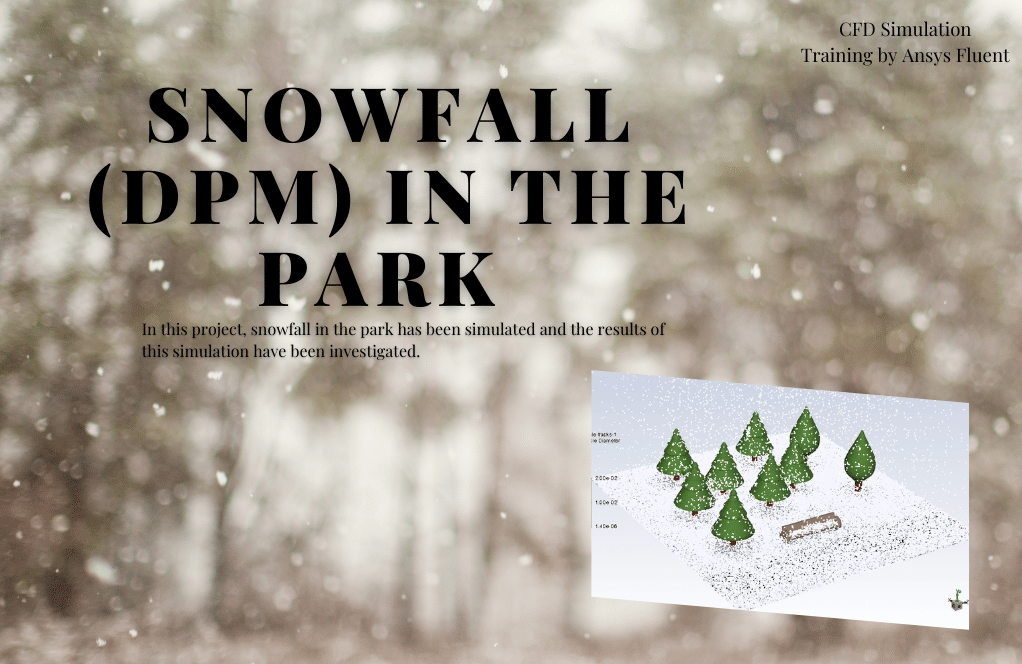


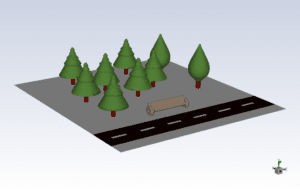
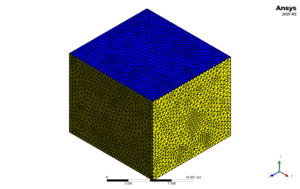
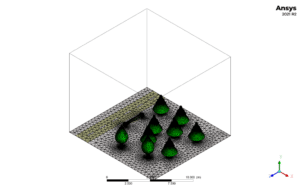
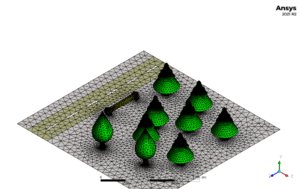

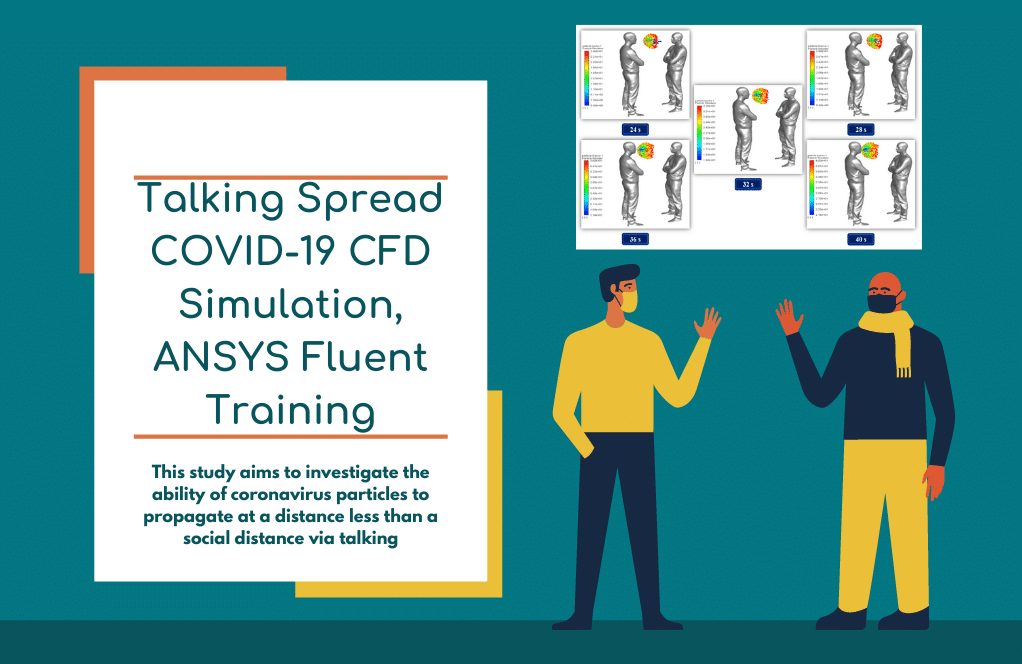
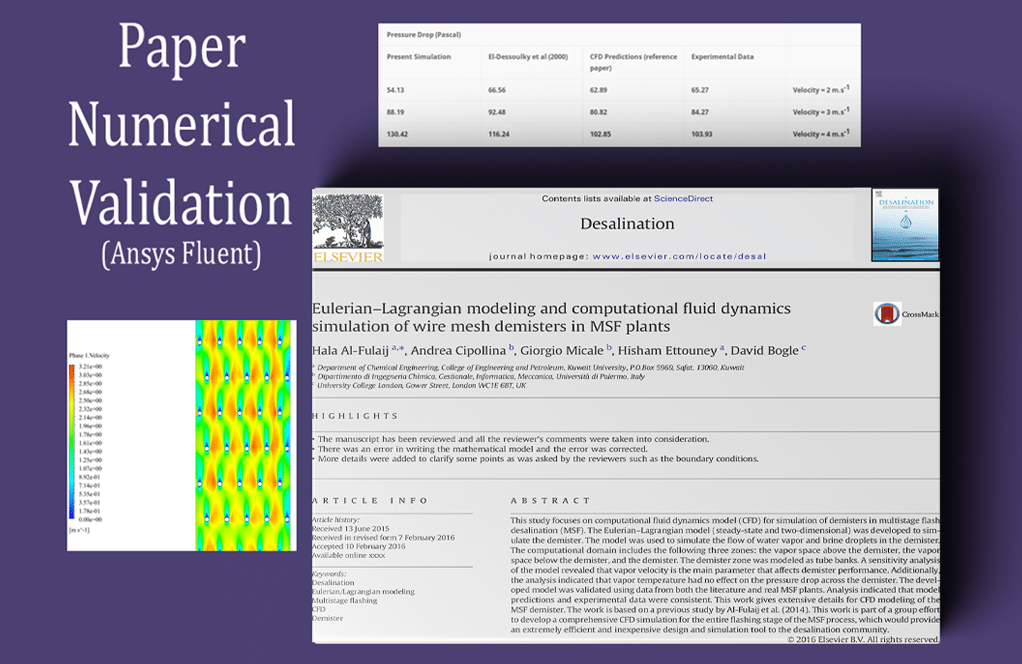
Fanny Dickinson –
Is the particle diameter distribution impact on snow behavior available in the results?
MR CFD Support –
The simulation takes into account a specific particle diameter distribution defined by the Rosin-Rammler equation. The results show particle tracking and snowfall animation, offering insights on how the chosen particle size distribution affects the behavior of the snowfall within the computational domain.
Miss Alicia Wolf –
The study of snowfall using the DPM method is fascinating. I couldn’t help but wonder how you differentiated between the effects of wind and gravity on the snow particles’ trajectories?
MR CFD Support –
In the simulation, the effect of gravity is accounted for through a set gravity value acting downward along the y-axis. The impact of wind is not directly specified in the described boundary conditions. However, because the simulation is transient, if wind or air movement is part of the environmental conditions within the park, it would typically be modelled as part of the velocity inlet conditions or as an additional force affecting the particles’ trajectories. The provided settings focus on the snow particles’ behavior under gravity’s influence, assuming either a negligible wind effect or that it’s a controlled variable not detailed in the description.
Gertrude Little –
How does the Rosin-Rammler distribution affect the snow particle simulation, especially because all diameters are the same size according to the specifications?
MR CFD Support –
The Rosin-Rammler distribution is used to describe the size distribution of particles within a spray. In this specific case, though all specified diameters are the same, theoretically indicating a monodisperse spray, the Rosin-Rammler distribution in Ansys Fluent could still define a narrow size distribution around the mean diameter to reflect a certain degree of polydisperseness found in realistic snowfall. This could help in capturing physical phenomena such as clumping or variation in snowflake descent due to slight size variations.
Prof. Rebeka Ritchie DVM –
Could the variation in snow particle size significantly affect the simulation results, and should this be taken into consideration for more accurate modeling of snowfall?
MR CFD Support –
In the Ansys Fluent simulation, a narrow snow particle size range defined by the Rosin-Rammler distribution ensures that all particles behave similarly. A larger variation in particle size would indeed affect the results, as bigger particles would fall faster and be more affected by aerodynamic forces, while smaller ones would remain airborne longer. If modeling more realistic snowfall patterns is the goal, then considering a wider size distribution and accounting for the variation in particle sizes is recommended.
Shanelle Thompson –
I’m intrigued by the use of the Rosin-Rammler distribution for snow particles. Can you explain how that affects the simulation results?
MR CFD Support –
The use of the Rosin-Rammler distribution allows us to account for a spread in particle sizes, which is typical for natural snowfall. This distribution provides a mean diameter size but also includes minimum and maximum diameter values, which leads to more realistic snow particle behavior and more accurate modeling of the snowfall pattern and deposition.
Napoleon Reichert –
Is there a specific reason for using the Rosin-Rammler distribution for the snow particle sizes in this simulation?
MR CFD Support –
Yes indeed, the Rosin-Rammler distribution is used because it provides a realistic representation of the range of sizes that snow particles have in nature, leading to more accurate simulation results of how snowfall behaves in different conditions.
Lane Witting –
The simulation description mentions that ‘Flow equations don’t solve.’ Could you please clarify what this means for the simulation results and the accuracy of the studies?
MR CFD Support –
Certainly, the statement ‘Flow equations don’t solve’ means that the air flow around the particles is not being simulated; only the particles’ trajectories are computed based on predefined conditions. This simplifies the CFD model by considering the air in the park as a stagnant medium. Accuracy for the particle movement is still maintained for the scope of studying the snowflake trajectories under gravitational effects, but this assumption may not capture the influences of wind or other air movements on the snowfall pattern.
Tamara Ratke MD –
Could you explain how the DPM boundary conditions and injection type work together in simulating snowfall?
MR CFD Support –
In this simulation, the DPM boundary conditions and injection type work together by defining how the snow particles interact with the air and other surfaces in the park. The injection type sets how the snow particles are introduced into the domain, dictating their initial size, distribution, and rate of flow. In this case, they’re injected as a surface velocity inlet, influencing their initial direction and speed. The boundary conditions determine how the particles will behave when they come into contact with other objects, like benches or the ground. If they ‘escape,’ the particles are assumed to leave the area after reaching that boundary. Symmetry conditions imply there is no interaction with the particles, and no-slip walls indicate the particles will stick or accumulate, just like actual snow does when it lands on various surfaces.
Ashtyn Green –
I just finished going through the Snowfall CFD Simulation training using the DPM method and I must say, the detailed explanation on each step made the learning experience very intuitive. The visualization of the snowfall animation was particularly impressive and gave me a much clearer understanding of how snow particles behave in different environmental settings. Kudos to the team for composing such comprehensive material!
MR CFD Support –
We’re thrilled to hear that you found the Snowfall CFD Simulation training and the snowfall animation visualizations valuable! It’s wonderful to know that our comprehensive material has contributed to your understanding of snow particle behaviors. Your feedback is much appreciated, and we look forward to providing you with more enriching learning experiences in the future. Thank you for taking the time to share your positive review!
Santino Kuvalis –
Excellent visualization of the snowfall process! Could this method also be used to study other types of particulate matter in the air, like pollution or dust?
MR CFD Support –
Thank you for the compliment! Yes, the Discrete Phase Model (DPM) is a versatile method that can be used to simulate other types of particulate matter in the air. It allows for the tracking of a wide range of particles, including pollution, dust, or any other dispersed phases.
Derek Mann –
In the results mentionD, does the snowfall animation provide insight into the distribution and accumulation of snow in different areas within the park?
MR CFD Support –
In the animation, we show how snowflakes are transported and distributed within the park environment. By observing the snowfall animation, you can see patterns of accumulation on various surfaces such as benches or ground.
Queenie Schuster –
How do the varying particle sizes and flow rates impact the simulation results and real-world snowfall representation?
MR CFD Support –
In order to accurately represent real-world snowfall in the simulation, different particle sizes and flow rates are crucial for capturing the variable nature of snowflakes. By using the Rosin-Rammler distribution in the Discrete Phase Model, we can effectively simulate a wide range of snowflake diameters, thus enhancing the realism of the snowfall behavior within the park. This variability influences not only the trajectories of snowflakes but also their residence time and deposition patterns on different surfaces like benches, leaves, and the ground, ultimately leading to more realistic results. If you have any more inquiries, feel free to ask!
Lysanne McLaughlin –
As the customer I appreciated the detailed simulation of snowfall patterns in a park setting; the methodology was well explained and the system’s customization options, such as the difference in particulate materials and boundary conditions, added depth to the training. The step-by-step guidance through setting up the DPM method and boundary conditions was immensely beneficial.
MR CFD Support –
Thank you for your kind words! We’re thrilled to hear you found the snowfall CFD simulation training beneficial in understanding the setup and execution of the DPM method in ANSYS Fluent. We aim to provide detailed and practical examples to help our customers. Your success is our satisfaction, and we’re glad that our product could contribute to your CFD learning journey.
Ona Bahringer –
I appreciated how the DPM method was utilized to simulate snowfall, and the animation really helped visualize the process. Great job on detailing the different elements and material properties in the setup!
MR CFD Support –
Thank you for your positive feedback! We’re thrilled to hear that the DPM simulation met your expectations and that the animation added value to your understanding of snowfall. If you have any further questions or need assistance in future simulations, feel free to reach out to us!
Amalia Bartell –
I was amazed at the level of detail in the simulation of snowfall in a park. The depiction of particle tracks and the snow animation truly enhanced my understanding of how snow behavior could be digitally replicated.
MR CFD Support –
We’re delighted to know that our Snowfall CFD Simulation using DPM in Ansys Fluent has provided you with a comprehensive understanding and holistic experience of snowfall dynamics. Thank you for sharing your positive feedback!
Ms. Maegan Nolan –
What computational effort is required to successfully simulate this snowfall scenario using DPM in Ansys Fluent?
MR CFD Support –
To simulate the snowfall scenario using DPM effectively, a significant computational effort is necessary. It involves a carefully generated unstructured mesh with over 1.5 million elements to capture the complex trajectories of the particles, and the transient nature of the simulation requires iterative calculation over each time step. Additionally, the settings for the discrete phase model, including aspects like injection type and particle diameter distribution, must be managed meticulously to accurately depict snowfall dynamics.
Demetris Ondricka III –
I would like to know if there is an analysis of the impact of snow on the various surfaces in the park, like the benches and trees. Is there a consideration for accumulation or melting in the simulation?
MR CFD Support –
In this simulation, we track snow particles and model their interception with surfaces within the park using the DPM method. The boundary conditions on the benches, ground, leaves, and other surfaces are set as stationary walls with a no-slip condition for the particles signifying particle capture by these surfaces. Currently, the scope of this simulation does not include accumulation or melting processes, as those phenomena would require additional modeling approaches beyond the DPM used here.
Orpha Murphy –
I am so impressed with the level of detail that went into simulating the snowfall in the park using the DPM method in Ansys Fluent. The assumptions made regarding flow and the inclusion of gravity’s effect on particle trajectories provide a realistic and practical view of snow accumulation and dispersion throughout the park. This is a remarkable use of CFD to visualize such a complex natural phenomenon.
MR CFD Support –
Thank you for your kind words! We strive to provide realistic simulations by taking into account all the necessary physical effects such as gravity on particle behavior. It’s gratifying to hear that the detail and effort have been appreciated. Your satisfaction with our product is our highest priority. If there’s anything further you’d like to know or discuss about the simulation, we are always here to assist you.
Julius Huel –
I’m intrigued by the use of the Rosin-Rammler distribution for snowflakes. How does this contribute to the realism of the simulation?
MR CFD Support –
The use of the Rosin-Rammler distribution allows us to account for the variation in size that would naturally occur in a snowstorm. By including a range of diameters, from the minimum to the maximum, we can more accurately model snowfall patterns and the resulting particle behavior as it interacts with the environment in the park.
Sunny Lubowitz –
The simulation deals with snow particles. Can you explain how the no-slip boundary condition affects the snow simulation on different surfaces?
MR CFD Support –
In the snowfall simulation using the DPM method, a no-slip boundary condition implies that when snow particles come into contact with surfaces such as benches, ground, leaves, lines, roads, and wood, they adhere to these surfaces instead of reflecting off or sliding along them. This mimics the actual behavior of snow particles accumulating on surfaces, contributing to the realism of the snowfall simulation. The ‘DPM=wall film’ property suggests that a film of particles is permitted to form on the walls, representing snow build-up during the simulation.
Elian Koss –
Which factors influence the trajectory of the snow particles in the simulation?
MR CFD Support –
“The trajectories of the snow particles in the simulation are influenced by several factors such as gravity, particle size and distribution, wind velocity, and interaction with various surfaces like benches, ground, and leaves. The DPM model in ANSYS Fluent tracks these influences to simulate snowfall accurately.”
Jackson Hickle –
The simulation description says the flow equations don’t solve. Can you clarify this? Does it mean the flow of air isn’t simulated, only the particles?
MR CFD Support –
The description you’re referring to indicates that the simulation focused on tracking the snow particles using the Discrete Phase Model (DPM) and did not solve flow equations for the air. This means that it modeled the trajectory of the snowfall without considering air movement or interactions, hence why the inlet air velocity is set to 0 m/s.
Dr. Krystina Hermiston MD –
I’m amazed at the detail of the tracked snow particles! Was actual weather data used to model the snowfall, or were the conditions predefined?
MR CFD Support –
In this simulation, snowfall conditions were predefined based on theoretical or assumed data rather than actual weather data. The set conditions allowed to create a controlled environment to simulate and analyze the trajectories of the snow particles within the virtual park.
Fannie Monahan –
This product sounds great for understanding snowfall simulation! Can you provide more insight into how the DPM simulation’s results help understand real-world snow accumulation patterns?
MR CFD Support –
Certainly, the DPM simulation results offer valuable insights into how snow particles move and accumulate over various surfaces. You can study the interactions of snow particles with different obstacles such as benches, roads, and trees within the park. By observing snowfall trajectories and accumulation patterns, you can estimate which areas would have thicker or thinner layers of snow, based on wind conditions and the park’s layout. This could be pivotal for urban planning or for preparing snow removal strategies in advance.